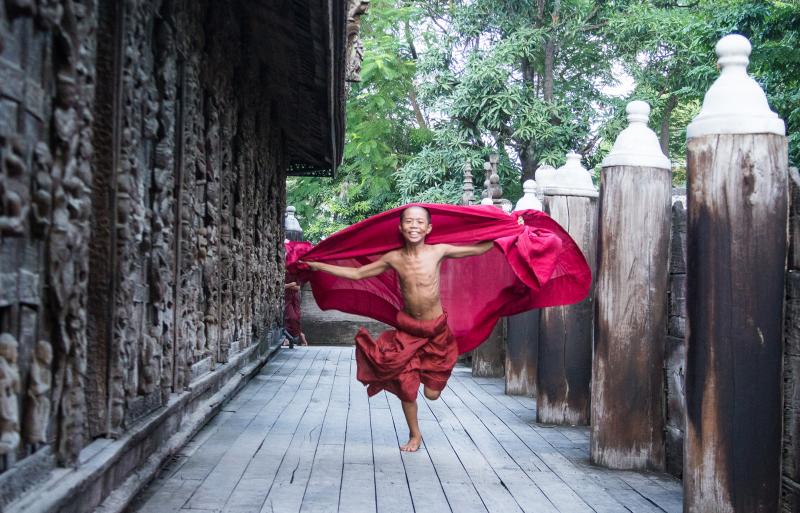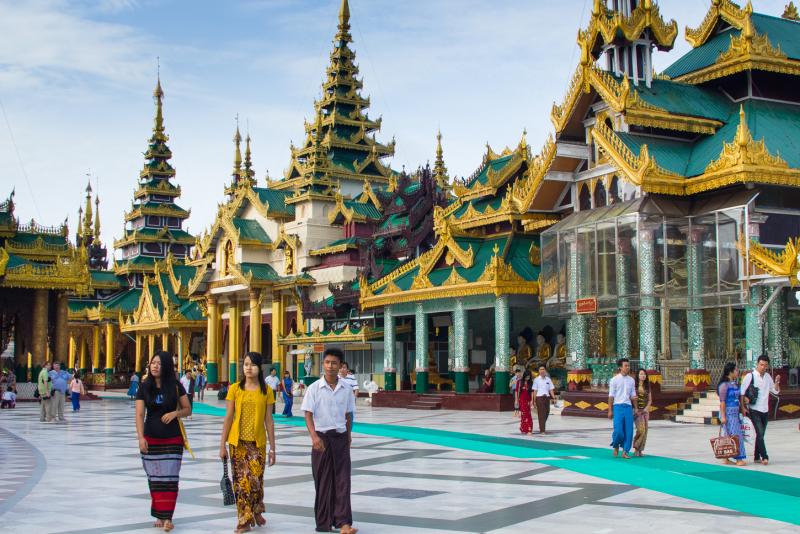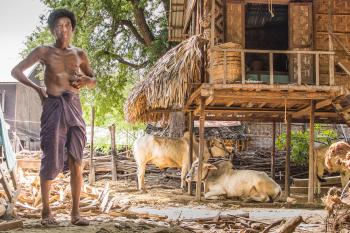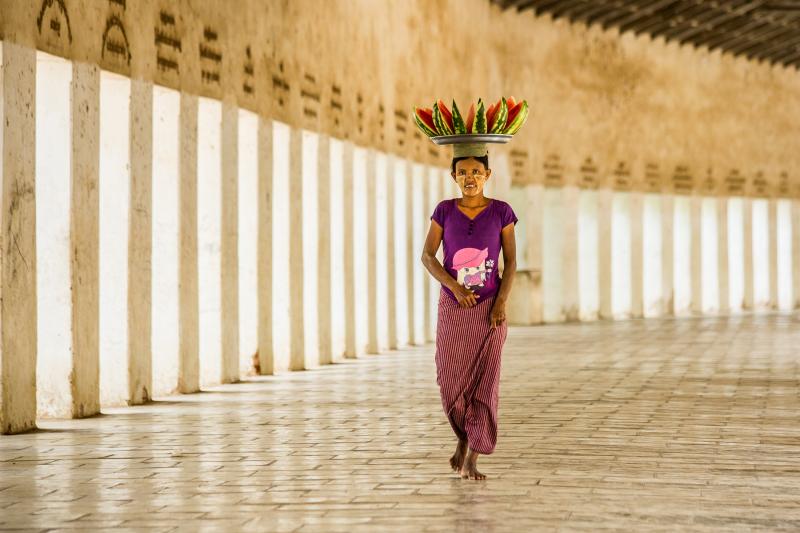Capturing amazing memories on a photo tour of Myanmar
This article appears on page 6 of the October 2016 issue.
We joined six amateur and two professional photographers for the “Amazing Myanmar” tour offered by Jim Cline Photo Tours (San Diego, CA; 877/350-1314, www.jimclinephoto tours.com) in September 2015. This 15-day tour was led by humanitarian photojournalist Karl Grobl, the company’s cofounder, with the assistance of local guide MM of Santa Maria Travels & Tours.
Pre-trip preparations
The very thorough pre-trip information we received for our tour included the URL of the Myanmar government’s website on which we could apply for an eVisa. We had no trouble obtaining our visas in this manner.
As Myanmar is largely a cash society, our pre-trip information also advised us to take only brand-new 100-dollar bills because they would fetch the best exchange rate. It also was stated that many of the hotels in Myanmar, which are owned by the government, do not accept bills that are marred in any way, and we found this to be true. (The desk clerk at our hotel in Yangon refused to accept a brand-new, crisp bill that had simply been folded in half.)
The tourism industry in Myanmar is relatively new, so we weren’t sure what our lodgings might be like. However, we were pleasantly surprised to find that the places in which we stayed compared very favorably with better hotels in the US. Our hotel in Yangon, for example, Kandawgyi Palace Hotel, had four restaurants, comfortable air-conditioned rooms, a large outdoor swimming pool and beautifully maintained grounds that overlooked a lake.
The cost of the trip, excluding international airfare, was $6,575 per person and included three internal flights, airport/hotel transfers, 14 hotel nights, all meals, boat rides, entrance fees and the services of an English-speaking guide (MM).
Starting in Yangon
Our first photo shoot in Yangon, at dawn, was at Shwedagon Pagoda. Measuring 328 feet tall, it is the most sacred Buddhist pagoda in Myanmar.
On our way to the pagoda, Karl gave us tips on camera settings and shooting possibilities. We soon learned that he would do this for each place visited, from the smallest market to major tourist sites.
As with all sacred sites in Myanmar, we entered Shwedagon Pagoda with bare feet, making our way up one of its four entrances. The pagoda was awash in gold, its huge stupa covered in gold leaf and solid gold tiles.
Many locals visit to make offerings at shrines corresponding to the day of the week on which they were born, and monks and other devotees engage in prayer throughout each day. Photographic opportunities abound.
Following our morning visit to Shwedagon, we embarked on a 2-hour drive to Bago, stopping at the Kyakhatwine Monastery along the way.
MM informed us that monks eat two meals a day, the first at 4 a.m., after which they leave the monastery to collect alms. We arrived at the monastery at 11:20 a.m., in time to photograph the monks as they assembled for their last meal of the day.
It was interesting to see how each monk was served a bowl of rice as he filed by a large, rice-filled steel container that was waist-high and about three to four feet in diameter. In the dining area, the monks sat on the floor at low tables to eat their meal.
After 30 minutes, they filed out to attend to their studies.
Next we stopped at one of many local markets we would see during our trip. The market was crowded with buyers and sellers of fruits, vegetables, spices, flowers and fresh and dried fish. People there were very friendly and didn’t mind having their pictures taken, which was true of everyone we met on our tour.
When it started to rain hard, we went to a nearby restaurant to have a Burmese meal, served family-style at a large table. It included vegetable soup, a variety of curries — lamb, fish, chicken — and rice. The meal ended with servings of fruit. The food was fresh and delicious.
While we were in Bago, Karl and MM learned that some men were practicing the traditional sport of chinlone nearby. In this sport, six players standing in a circle attempt to keep a hollow rattan ball, roughly the size of a soccer ball, in the air using only their knees, heels, elbows, shoulders and heads. We watched in amazement at the difficult, intricate moves made by the players.
We also went to see the 180-foot-long reclining Buddha in Shwethalyaung Temple. (The Buddha’s little finger is 10 feet long!)
Upon returning to Yangon, we went once more to Shwedagon Pagoda for an evening photo shoot. Shrines at the pagoda were lit with animated, flashing lights, reminding us of Las Vegas.
On to Mandalay
The next day we left our hotel at 5:30 a.m. to fly to Mandalay. After arriving, we stopped at a small village near Amarapura to mingle with the locals. Children were playing, men were caring for their animals, and a few women were washing clothes on the bank of a river.
We checked into our hotel, Rupar Mandalar Resort, before going to Shwenandaw Monastery, an ornately carved teak structure that was originally part of the royal palace in Amarapura. MM had arranged for two young monks to serve as models for our photo shoot at the monastery.
Following this, we took an open-air bus to the top of Mandalay Hill. It was a wild ride around curving roads. We bounced around a lot and had to hold on, but it was fun.
Mandalay Hill is known for its abundance of pagodas and monasteries. It’s a Buddhist pilgrimage site, with excellent views of the surrounding area.
While in the Mandalay area we also visited the Mahamuni Temple, the holiest Buddhist shrine in upper Myanmar. The central attraction at this temple is a 12-foot-high statue of the Buddha covered with several tons of gold leaf, applied over many years by worshipers showing reverence. So much gold leaf has been applied that the features of the statue have become distorted.
We also visited the Monastic Free Education School during their lunchtime recess. The principal told us that the school serves 2,500 children, ranging from kindergarteners to those in grade 11. Sixty-five of the students live at the monastery; the others come from surrounding villages and nunneries.
More photo-worthy sights
The next day we boarded a private boat for an 80-minute ride on the Ayeyarwady River to Mingun. Getting off the boat was somewhat of an adventure. As the boat could not be brought close to shore, we had to walk down a narrow plank that was supported by men who were waist-deep in the water.
After disembarking, we took a motorcycle taxi to the Hsinbyume Pagoda for another photo shoot with monks. This impressive, unfinished white pagoda is sometimes referred to as the “Taj” because it was constructed by Bagyidaw in memory of his consort, Princess Hsinbyume, who died in childbirth.
We ended our day at the famous U Bein footbridge, which spans Lake Taungthaman, taking photographs of it from rowboats in the lake.
On the sixth day of our tour, we came upon a flower market selling a variety of fresh, locally grown flowers. Huge bundles of flowers were loaded onto the backs of motorcycles for delivery to shops in the surrounding area. We stopped to take pictures before continuing up a steep, winding road leading to the colonial hill town of Pyin Oo Lwin, formerly the summer capital of Burma under British rule. The town is famous for its horse-drawn stagecoach carriages, in which we enjoyed a ride.
We walked through town and explored its market, where you could buy just about anything you might need.
That night, we returned to Mandalay for dinner and a marionette puppet show.
Bagan
Our morning stop the next day was the King Galon shop, where they produce the gold leaf that many worshipers use at temples, a process that we found most interesting.
Squares of gold foil, about 6 to 8 inches on a side, are placed between sheets of special paper to prevent them from sticking. Then they are bundled together in layers to form a thick packet, and a worker continuously pounds the packet with a sledgehammer for 30 minutes at a time to create the thin sheets. Time is kept by a simple water clock.
As the packet is hammered, the gold becomes warm and spreads inside each layer. Hammering must be continuous to prevent the gold from cooling and becoming less malleable.
After a leisurely lunch, we headed to the Mandalay airport for our flight to Bagan, where we arrived in time for a sunset shoot at Shwesandaw Pagoda before continuing on to our accommodations, The Hotel @ Tharabar Gate.
The following day, we skipped the 5 a.m. sunrise photo shoot and opted for a leisurely breakfast at our hotel. We rejoined our group later to take photographs in the Nyaung Uo Market and do a photo shoot in the causeway leading to Shwezigon Pagoda. Monks use this causeway to return to their monastery after collecting alms.
Bagan is noted for its Archeological Zone, where there are over 2,000 monasteries, temples, shrines and stupas that were built over a 200-year period. Many people photograph the sunset from atop the temples, while herders graze animals among them.
Karl and MM knew exactly where and when the herders would be bringing in their animals for the night, providing an excellent opportunity for us to take picturesque photos at “goat junction.”
An unexpected ending
We were now into the ninth day of our tour, and everyone was given a free day to do as they pleased.
At this point, our group was getting a bit tired of Burmese food, and we jokingly told MM we wanted pizza. Sure enough, he found a place that served it.
The proprietor told us his was the best pizza in town, but it was probably the only pizza in town. He had only one small, wood-fired oven, so by the time we were served, most of the others in the group had finished eating. Nevertheless, the wait was worth it because the pizza was excellent!
That evening, as we were getting ready for dinner at our hotel, disaster struck. Julie slipped and seriously broke her arm. This ended our tour. We missed the last five days, including Inle Lake, which we were looking forward to seeing.
MM and the folks at Santa Maria Travels went out of their way to get medical treatment for Julie in Yangon, and they helped us make arrangements for our 30-hour trip home.*
Karl, Jim and Kat, the folks at Jim Cline Photo Tours, gave us support throughout and followed up with us after we were back home. We feel like they’re our family now. Theirs is an exceptional tour company, and we have plans to travel with them to other destinations.
We also plan to return to Myanmar independently to travel with Santa Maria Travels & Tours. It, too, is an exceptional tour company.
As photographers, we always want to be in the right place at the right time to take advantage of the light and whatever activities may be taking place. Having collaborated for many years, Karl and MM worked smoothly as a team to insure our group had the best experience possible.
Despite Julie’s misfortune, we had a wonderful time on the “Amazing Myanmar” tour. It was one of the best photo tours we have taken, and we highly recommend it. F
*A recounting of the Cassens’ ordeal was printed in the July 2016 issue on page 27.




